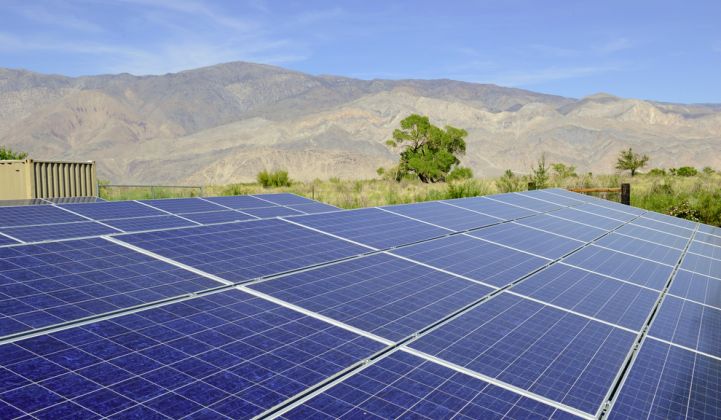Community solar offers a solution to residents who want clean power but don't have access to a sunny, sizable roof. It comes with a big catch, though: Certain enabling policies are needed to credit individuals with the electricity generated at an offsite solar farm.
That challenge has limited the reach of community solar to the few states that have adopted such policies, including Colorado, New York, Minnesota, Massachusetts and Washington, D.C. This leaves few options for most of the 49 percent of households that can't put solar on their roof because they rent or their roof is too shaded.
D.C.-based energy startup Arcadia Power launched a product last week that bypasses this policy obstacle and pushes savings from community solar arrays straight onto customers' utility bills -- all over the country. This model tosses out the conventional wisdom on shared solar policy and replaces it with a technological fix. If it succeeds as a business model and makes customers happy, this approach could open up solar access much faster than conventional community solar can.
Arcadia's business model hinges on proprietary software that the company developed for its first product, a wind energy credit. Under that program, residential customers can pay a small premium to offset their energy use with wind energy credits.
To track customers' monthly energy use, Arcadia partnered with about 100 utilities to integrate its software with their billing systems. The software functions like financial tech offerings like Mint.com, in which customers give a company access to their billing accounts in order to gain valuable services.
Some 12,000 customers paid more for the knowledge that they were bringing clean energy on-line. With the new solar product, they'll actually save money.
Visitors to Arcadia's website can subscribe to a number of solar panels on an upcoming project that Arcadia develops. Current offerings are a rooftop project in Washington, D.C. and a church in Arlington, Massachusetts. The cost and estimated monthly savings vary depending on the location and size of the project.
Arcadia develops each project as a behind-the-meter solar farm, netting the renewable energy credits and tax equity in the process, and selling the generation to a local offtaker. Those particular electrons don't go to customers around the country. Instead, the company tracks the real-world production of the specific panels belonging to each customer, calculates the value of that generation based on an agreed-upon dollars per kilowatt-hour rate and credits the customer's utility bill with that amount. The customer can monitor the production with an online dashboard.
The subscription can travel with a customer from residence to residence, provided the new home lies in the territory of a participating utility. And the modular subscription model allows the customer to ask for as many panels as he or she wants, from one panel up to however many zero out their electricity bill.
Target market
So far, Arcadia has built 250 kilowatts of solar capacity and has 2 megawatts more in the pipeline, said founder and CEO Kiran Bhatraju. The number of subscribers since last week's launch is "already in the hundreds."
The savings from this service won't match what's possible with rooftop solar, he admitted, but that's not the point.
"If you have a south-facing roof in a state where it's economic, you should do rooftop solar," Bhatraju said. "That’s not our market."
The market, instead, is all the people who want solar power, but can't put it on their roofs, because they rent, or will move within a few years, or live in a state with poor economics for solar. This is a significantly better option than no option at all.
This model sounds too good to be true. It employs technology to sidestep the typical shared solar challenges of bill credit mechanisms and interconnection policies, resulting in a product that's more flexible and user-friendly than virtually any other solar offering. Arcadia managed to secure the cooperation of more than 100 utilities across 50 states.
It's not immediately clear what the utilities have to gain from participating, except the increased satisfaction of their customers, or a preliminary way to gauge interest in shared solar.
"At the end of the day, your local utility is still getting paid the full amount for the generation, transmission and distribution to your utility account," Bhatraju said. "They’re still being compensated for the work they’re doing."
And, if some of those utilities want to get involved with more conventional community solar, Arcadia can help them out as a project developer, he added.
Customer acquisition
The true test of Arcadia's ingenuity will be whether it continues to gain customers. The model appears scalable -- it just requires more development to meet more demand.
"If this business model proves to be promising and can actually be applied in all 50 states, which in and of itself seems quite challenging, it would definitely redefine what we’re currently seeing in the community solar and shared solar policy world," said Sara Baldwin Auck, regulatory program director at the Interstate Renewable Energy Council. "It theoretically creates a lot of new opportunities for customers, but poses a new set of challenges."
One main challenge will be educating consumers about this novel approach to solar. Then there's the matter of ensuring the customers all get what they pay for, since they may live across the continent from the actual panels they subscribe to, and thus have no way of verifying the energy generation firsthand.
The decoupling of community solar customers from the photovoltaics also separates them from local grid benefits. Customers won't be improving the air quality where they live by reducing the need for fossil fuel generation, or saving on local distribution upgrades by erecting distributed energy resources. But that may be a small price to pay for people who wouldn't be able to join any community solar programs otherwise.



